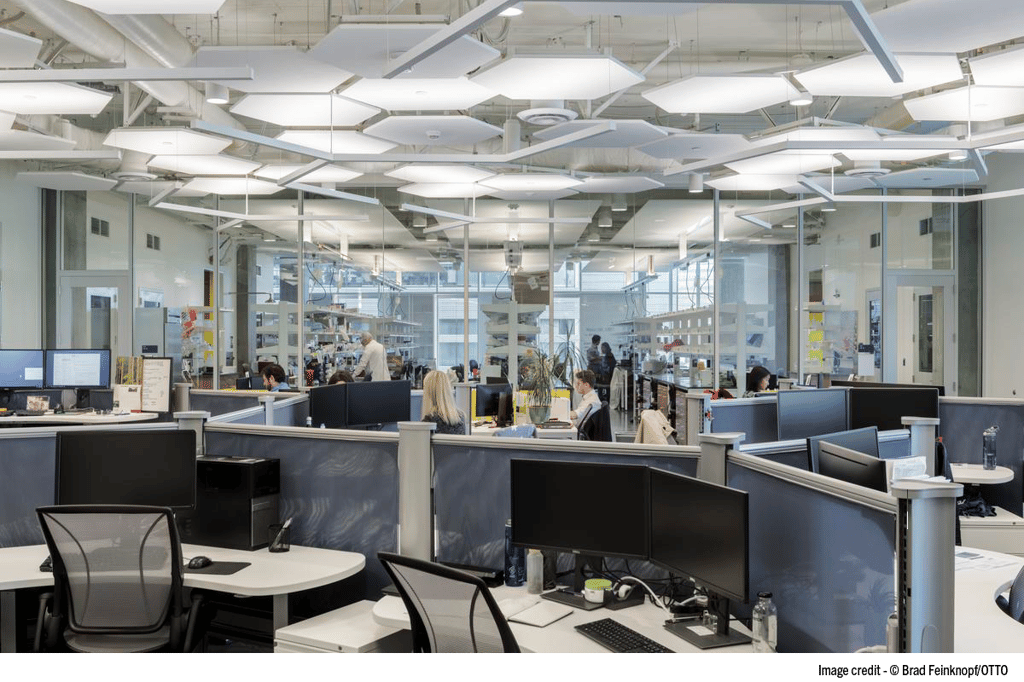When you are creating space for people whose work will impact the future of humanity, it makes you think very seriously about what needs to be different. The Knight Cancer Research Building (KCRB) is the culmination of decades of work to eradicate one of humanity’s most prevalent and devastating diseases.
Fundraising began in 2013 with an ambitious goal to build a world-class laboratory building to bring teams of driven and talented scientists together to work on complex issues and bring us all closer to a healthier, cancer-free future. In September 2018 the OHSU Knight Cancer Institute opened its doors to a new era of cancer research.
Honoring the culture of invention championed by the building’s benefactor, Nike Founder Phil Knight, B+H Advance Strategy entered into a collaboration with building architects SRG Partnership to conceptualize the next generation of high-tech, leading-edge laboratories.
Where to Start?
With the people who will change the world. Realizing a creative, productive environment has to begin with a deep understanding of the ways people want to interact with their space. The B+H Advance Strategy team conducted extensive research aimed at providing insights into two primary questions:
- How is research currently conducted in the Knight Institute labs?
- How might the research of successor generations look different?
To that end, we conducted job-shadowing and hosted social gatherings to engage with scientists, researchers, experimentalists, computationalists, and people in many different roles who could provide insight into the complexities and challenges of working together in pursuit of a life-changing ambition.
The Past Is No Longer Predictive of the Future
We have a belief around here that in times of exponential change, we should regard our past experiences as informational at best, cautionary at worst when it comes to planning for the future. Our research confirmed the importance of setting aside preconceived ideas about historically successful research environments, revealing distinct divergences from traditional patterns.
Divergent Collaboration Patterns
Analysis of collaboration patterns revealed distinctions between experimentalists and computationalists. Most experimentalists collaborate in situ in the wet labs; at the bench, write-up area, or on a screen. This phenomenon explains the mostly unused and empty “collaboration” spaces provided by well-intentioned designers in benchmark research labs.
In contrast, computationalists behave more like typical tech sector developer teams who will travel to designated collaboration spaces to work together without disturbing the focused work of others.
Generational Divide
We are in an interesting transitional phase in the workforce in the US. Baby Boomers are retiring at a rate of 10,00 per day yet are still typically the ones making decisions on behalf of their successor generations. We convened a focus group of young scientists to understand their values and work preferences. Much like their peers in other sectors, we confirmed a preference for flatter organizations that allocate space to teams, rather than individuals and provide accommodation for function rather than status. The more fluid, improvisational nature of less-hierarchical teams requires a high degree of flexibility and choice in the workplace, minimizing fixed elements.
“We Are Not Google!” (Yet)
In the course of our investigations, one member of the scientific leadership claimed, “we are not Google.” Testing this assertion through job-shadowing and focus groups, we discovered that the work patterns of computationalist scientists are mostly indistinguishable from those of their counterparts in the technology sector. Furthermore, we noticed an infiltration of computationalist-like data analysts into Experimentalist research groups., suggesting that the two working styles may converge in the future.
It Was Time to Rethink the Lab
Fueled by insights gained through user observation and engagement and translating successful strategies from other sectors into the lab environment, our work informed the creation of a new kind of research environment.
Bryan Croeni, who led the workplace strategy for B+H, observed, “Our profession has a bias towards bricks and mortar that sometimes obscures the importance of human factors, but the most important work may well happen outside of the laboratory.”
We observed a close relationship between collaboration and socialization with researchers “toggling” back and forth between the two, confirming the need for strategically conceived and located collaboration and social spaces that will play a central role in building culture and fostering Team Science.
At KCRB today, open and transparent work stations allow a free flow of ideas and information. Laboratory and office spaces arranged in “neighborhoods” provide manageable, flexible research space with extensive glass partitions and walls throughout. Exterior balconies and the rooftop terrace with views to the Willamette River provide fresh air and space to unwind. The 200-seat auditorium and additional meeting rooms allow for more effective presentations and small group collaboration.
So, perhaps research institutions are not Google – yet – but significant and growing portions of their organizations are clearly heading in that direction. With this insight, we were able to propose to senior scientific leadership a future-proof building design. Looking forward, the most critical leaps may well happen outside of the lab.

